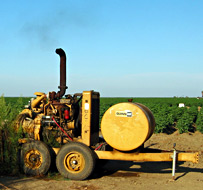Pacific Southwest, Region 9
Serving: Arizona, California, Hawaii, Nevada, Pacific Islands, Tribal Nations
 Benefits and Concerns
Benefits and Concerns
On this page:
BenefitsBenefits
Environment

Air Quality
Reduces emissions of harmful air pollutants such as asthma-causing fine particles, greenhouse gases, and acid rain forming sulfur dioxides.
Reduces carbon dioxide emissions.
Waste Minimization
When waste cooking oil is used in the production of biodiesel, a waste is diverted from municipal solid waste landfills and sewer systems.
The energy from waste cooking oil is recovered and converted into a product - a domestic, renewable, alternative fuel.
Water Quality
Local water quality is significantly improved. Therefore, fewer sewer spills contaminating streams, lakes, and bays happen because less fat, oil and grease accumulates in the public sewer pipes.
Environmental Risk
Unlike conventional diesel, biodiesel is non-toxic, biodegradable and safer to ship. Spills do not require emergency response clean-up activities.
Energy
- Biodiesel is a renewable resource that can be produced domestically from animal fat, vegetable oil or used cooking oil. This decreases the country's dependence on imported foreign oil.
- The Department of Energy analyzed the full biodiesel life-cycle and found that for every unit of fossil fuel used to produce biodiesel, 3.2 units of energy were gained. By contrast, petroleum diesel's life cycle yields only 0.83 units of fuel product energy.
Economics
“Biodiesel is one of our nation's most promising alternative fuel sources. And by developing biodiesel, you're making this country less dependent on foreign sources of oil.” -
- Diesel fleets do not require costly conversion methods or technologies to switch from petroleum diesel to biodiesel unless the existing equipment is older than 15 years.
- The IRS runs a tax credit program
 with a subsidy of 50 cents to $1 per gallon of biodiesel produced.
with a subsidy of 50 cents to $1 per gallon of biodiesel produced.
- The Department of Agriculture and the Congressional Budget Office have stated that biodiesel is the cheapest alternative fuel for meeting the Energy Policy Act (EPAct) requirements.
Concerns
Did You Know?
- There were 75 million gallons of biodiesel sold in the U.S. in 2005. That’s enough to fill 115 Olympic size swimming pools!
- That every hour there is enough waste grease produced in the United States to fill 130 tanker trucks.
- Clark County School District in Nevada is the largest school bus fleet in the United States to run on biodiesel.

Quality and Performance
If biodiesel is to be sold in the US, it has to meet quality and performance standards of many agencies and organizations.
- The American Society of Testing Materials created a standard for biodiesel sold in the US (PDF) (1pp, 27kb).
- EPA approved biodiesel as an alternative fuel and a fuel additive.
- Biodiesel meets most clean diesel standards established by the California Air Resources Board.
- Biodiesel offers increased lubricity, high cetane and high oxygen content, which helps with performance and extends the life of engines.
- The National Biodiesel Board established a quality assurance program entitled BQ-9000 to monitor the quality of biodiesel in response to differing fuel qualities offered on the market.
Nitrogen Oxide Emissions
Nitrogen oxides (NOx) are a group of gases that form when fuel is burned at high temperatures. These gases contribute to ground-level ozone, acid rain, and visibility impairment. Over half of human made NOx emissions come from fuel combustion in motor vehicles.
The trend of NOx emissions from use of biodiesel is still uncertain. Several studies show an increase in NOx emissions, while others show a decrease. Further research is still needed on NOx emissions from engines burning biodiesel.

EPA has funded several projects to address the NOx emissions. In the "Fields to Fuel" San Joaquin Valley Biodiesel Project, the grantee will test a NOx reduction additive in real world applications on the farm. In another project, the University of Nevada at Reno (UNR) focuses on removing nitrogen before fuel production and will build a large-scale mobile continuous processing unit to lower costs of biodiesel.
